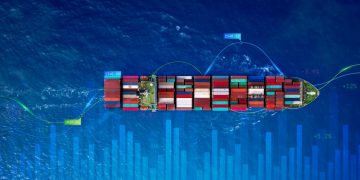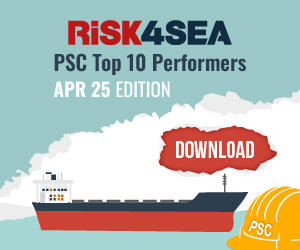The 2023/2024 Shipping Industry Flag State Performance, published by the International Chamber of Shipping (ICS), indicates continuing positive performance by the vast majority of Flag States which are responsible for the safety and environmental performance of the world’s merchant ships.
Nevertheless, it is strongly emphasised by ICS that the age of an individual ship is not an indicator of quality, and that the condition of an individual ship is ultimately determined by how it is maintained.
Highlights
- Updated Flag State Performance Table shows an increase in positive performance indicators amongst smaller Flag States.
- Flag States that have a majority of negative indicators highlights the need to encourage shipowners and operators to examine whether a Flag State has sufficient substance before using it.
- Ship operators in dialogue with maritime Administrations are recommended to use the Table to identify areas for further improvement over the next twelve months.
The Table is intended to encourage shipowners to maintain a dialogue with their flag States, and help facilitate any necessary improvements in the interests of safety, environmental protection and decent working conditions.
As in previous years, a number of Flag States have shown positive indicators for all of the criteria used in the Table. These include:
- Bermuda
- Cayman Islands
- Denmark
- Greece
- Hong Kong (China)
- Japan
- Liberia
- Malta
- Marshall Islands
- Norway
- Portugal
- Singapore,
- and the United Kingdom.
In the 2023/2024 Table, a number of Flag States (including Togo, Algeria, and Comoros) continue to record large amounts of negative performance indicators, highlighting the need to encourage shipowners and operators to examine whether a Flag State has sufficient substance before using it. Positively, a number of smaller flag States, including Costa Rica, Egypt, Mexico, and Thailand, show an increase in the number of positive performance indicators compared to the previous Flag State Performance Table.
Overall improvements were seen this year in flag State’s attendance at International Maritime Organization (IMO) meetings, as well as in the use of well-performing Recognized Organizations authorised by flag State administrations – as shown by Port State Control inspection data – to carry out the survey and certification of ships to ensure compliance with IMO and International Labour Organization (ILO) regulations governing safety, environmental performance and labour standards.
The information in this year’s highly anticipated ICS Flag State Performance Table continues to be positive, with notable improvements in several areas including governments’ attendance at IMO meetings. It is a positive development that this year’s ICS Flag State Performance Table shows that smaller Flag States have shown improvements in performance.
…Guy Platten, Secretary General, International Chamber of Shipping, said.
I encourage shipowners and operators to use this vital tool to examine whether a Flag State has sufficient substance before using it, and to put pressure on their flag Administrations to affect any improvements that might be necessary, especially in relation to safety of life at sea, the protection of the marine environment, and the provision of decent working and living conditions for seafarers.
..Guy added.
Methodology
Port State Control
A simple means of assessing the effective enforcement of international rules is to examine the collective Port State Control record of ships flying a particular flag. The three principal Port State Control (PSC) authorities are the countries of the Paris Memorandum of Understanding (MOU), the Tokyo MOU and the United States Coast Guard (USCG). All three authorities target particular flags on the basis of deficiencies and detentions recorded for ships flying that flag. The Table identifies flag States that feature on the Paris and Tokyo MOUs’ white lists and that have fully qualified for the USCG’s Qualship 21 program, and those which do not appear on their respective black lists/target lists. Ships whose flag States do not appear on PSC white lists tend to be subject to a greater likelihood of inspections.
The Table now also identifies those flags whose ships suffered no detentions within a particular PSC region over the previous three years, but did not meet the relevant minimum requirement of inspections or arrivals to be included in the MOU white lists/ Qualship 21 program. In order to be identified in this way with respect to the Paris and Tokyo MOU white lists, a flag must have undergone at least one inspection in the previous three years. With respect to the Qualship 21 program, a flag must have made at least three distinct arrivals in each of the previous three years. As regards the USCG Target List, flags which are listed as ‘Medium Risk’ on the list are identified with a neutral indicator. This is in alignment with the way in which the three PSC authorities present this information.
Use of Recognized Organizations in compliance with the IMO RO Code
The IMO Code for Recognized Organizations (RO Code) requires flag States to establish controls over ROs conducting survey work on their behalf, and to determine if these bodies have adequate resources for the tasks assigned. The RO Code also requires flag States to submit data to IMO on the ROs authorised to act on their behalf.
The Annual Reports released by the Paris and Tokyo MOUs on Port State Control contain ‘Performance Lists of Recognized Organizations’, which rank each RO into high-, medium-, low- and very low-performing. Using a combined list of high-performing ROs from the Paris and Tokyo MOU lists, the table positively identifies flag States which employ as many or more high-performing ROs, as they do non-high-performing ROs, and which have submitted their RO related data to the IMO in line with the RO Code.
Age of fleet
A high concentration of older tonnage under a particular flag does not necessarily mean that this tonnage is in any way substandard. However, a flag which has a concentration of younger ships may be more likely to attract quality tonnage than a flag State with a high concentration of older vessels.
The average age is determined based on analysis of aggregated data of ships registered under a particular flag State. As a positive indicator, the Table therefore shows the 90% of flags (among those listed) that have the lowest average fleet age (the bottom 10% of those listed having the highest average age). Nevertheless, it is strongly emphasised by ICS that the age of an individual ship is not an indicator of quality, and that the condition of an individual ship is ultimately determined by how it is maintained.
































































